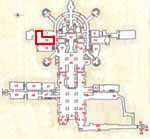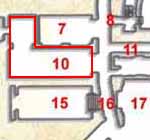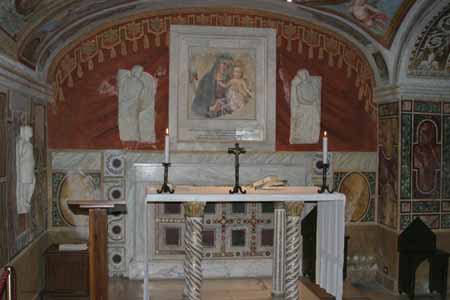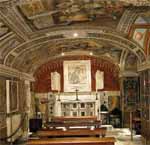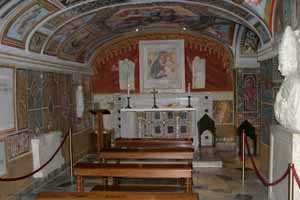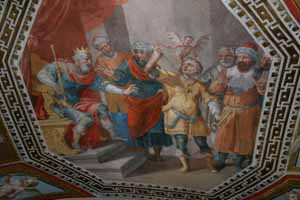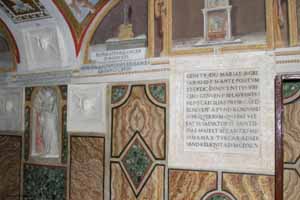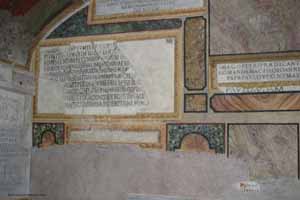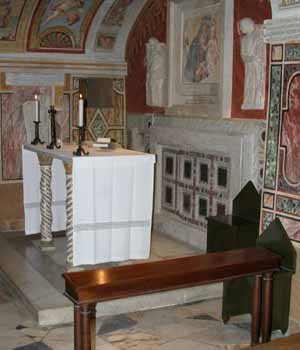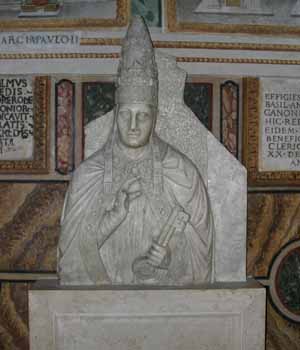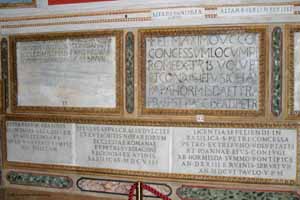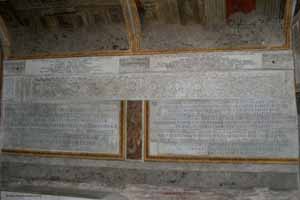| Grottoes
Vatican City Colonnade Saints Floorplan #2 |
| Altars
Monuments The History |
|
Related Links |
|
The biggest among the old chapels in the grottoes, this chapel was created by Paul V in 1616, by opening the outside wall of the peribolos (the present entrance) and by excavating under the floor of the basilica. It was the first chapel in the grottoes to be dedicated to the Madonna and, despite the 20th century modifications, it has preserved its ancient flavor as well as the atmosphere and the memory of the Constantinian basilica. |
|
|
|
|
|
|
|
|
|
|
|
|
|
|
|
When the structure of this new oratory was completed, on October 5, 1616. Pope Paul V placed above the altar the image of Our Lady, venerated as the Madonna of the Parturient. The name comes from the special devotion that women expecting a baby manifested towards the painting when it was still in the old basilica. In the old basilica, this sacred image of the Madonna was located in the left transept, in a shrine with an altar founded by Cardinal Giovanni Gaetano Orsini (d. 1385) and later decorated by Cardinal Giordano Orsini (d. 1438). When the transept was demolished, the fresco was salvaged and in 1574 was placed and venerated on the dividing wall between the old basilica and the new one under construction. In 1605, when it was decided to demolish the remaining part of the Constantinian basilica, the sacred image was taken to the back of the old Grottoes. That location, however, was not easily accessible. Eventually, it was placed in this new chapel. The painting is a surviving fragment of an early Renaissance fresco attributed today to Antoniazzo Romano (1452-1510) and his workshop. Judging by the wings of the angels around the figure of the Virgin, the painting must have once been bigger. In the past, it was protected by an aedicula with four Cosmatesque columns from the tabernacle of the Holy Veil. In 1950, it was inserted in a white Carrara marble frame with an inscription commemorating the restoration by Pius XII. |
||||||||||||||||
|
The image is full of noble grace and delicate sentiment. The Virgin's affection for the Child is immediately perceptible. With her left hand she is holding the standing Baby Jesus to her bosom while He is giving His blessing. In her right hand, in a gesture of respect, Mary is holding a transparent veil in front of the Child. The Virgin is bending her head towards the jovial face of the Son but, at the same time, she is gazing at the faithful turning to her. On the sides of the image are two fragments of late Medieval Angels reggicortina (holding a drape), in bas-relief. In 1950, the
original altar sitting against the wall, was replaced with the present
one, assembled from ancient fragments. The present arrangement goes
back to 1984, when the altar was moved away from the wall to allow
Mass facing the congregation. The table sits on four Cosmatesque
columns. The two at the back are of the same making and many have
come from the funerary monument of Urban VI (d.1389). On their golden
capitals are eagles spreading their wings from the family crest
of the pope.
Affixed to the wall, under the fresco of the Madonna, is a Cosmatesque decorated marble panel, in two integrated pieces. The two marble strips to the sides are in the same style. The entire surface of the vault of the chapel was frescoed by Giovan Ricci da Novara between 1618 and September 1619. Along the center are three panels in a vertical succession. Here the damaged original frescoes of Ricci were heavily repainted in the 18th century. In the first octagonal panel above the altar, is The Eternal Father surrounded by clouds, angels and cherubs. In the center is St Zoe Arrested at the Tomb of Peter, who , according to the Passion of St Sebastian, was arrested when she was praying in front of the tomb of Peter in the Vatican cemetery. For this reason, in 303, during the persecutions of Emperor Diocletian, Zoe was imprisoned and martyred. The painting shows the guards thrusting themselves upon Zoe who is praying in front of an idealized Confession, below is the relative inscription.
The last, octagonal panel, close to the entrance, represents The Longobard and the Key of St Peter. In a well-balanced composition the artist illustrates an episode narrated by Gregory the Great. In the foreground are the two protagonists of the story: the Longobard, who in a sacrilegious gesture tries to break the golden key from the sepulcher of Peter and then, taken over by an evil spirit, slits his own throat; and Autari, the king of the Arian people, who repairs the damage. The inscription below commemorates the event. To the left on the lower part of the vault, are some of the monuments of the old basilica. In the first span, close to the altar, is Giotto's Navicella, the grand mosaic designed by Giotto for the portico of the old basilica, with the scene of Peter saved by Jesus on the water. In the second span is the Altar of the Blessed Sacrament. In the last one, close to the entrance, is the Altar of St Leo IX, also called the altar "of the Dead", because it enjoyed special prerogatives and indulgences for the souls of the dead. Finally, is the Altar of St Andrew, commissioned by Pius II, with the grand statue of St Andrew placed there in 1570, now on display in the sacristy of the basilica. Immured on the right wall, are a number of ancient pieces.
Close to the altar is St George and the Dragon, originally from a marble arch by an anonymous 15th century artist. Next, in a travertine frame, is an original fragment of Giotto's Navicella with the representation of the bust of an angel. It was discovered in 1924, underneath the surface of another mosaic of an angel that was superimposed in 1728. Below is a marble slab from the base of a column in the Constantinian basilica, with the funerary inscription of FELIX DIAC(onus) of the Roman church, deposited in 435, during the 15th consulship of Theodosius and 4th of Valentinian. Next is the funerary inscription of MARCELLVS, sub-deacon of the VI ecclesiastical region of Rome, which, at the time, corresponded to the area of Ostiense, Appio and Ardeatino. His burial is dated to the XXII year after the consulship of Basilius, i.e., 563. The concession to bury him in St Peter's was granted A BEATISSIMO PAPA IOANNE (John III). Next is the mosaic of an angel commissioned in 1728 by Benedict XIII to cover the damaged mosaic by Giotto, as described above.
The next item
on display is the funerary inscription of PETRVS, ex - tribune voluptatum,
i.e., responsible for public entertainment and games, and of his
wife IOANNA. In 523, two more permissions for burial in the basilica were granted by PAPA HORMISDA and by TRAN(smundo). Next is the funerary inscription of DVLCITIVS and EVTICHE, the church notaries, and of PETRVS, sub-deacon of ecclesiastical Region I, corresponding to the area of Campus Martius. Peter bought his sepulcher in his lifetime, but it was used first for two more people, and example of a threesome burial. In the corner close to the entrance, is a marble plaque with a Cross from the old basilica, as indicated by the caption. Below, is a small funerary inscription of IOANNES ALICANSIS, i.e., from the city of Halicie in Sicily, today called Salemi. In the text is a reference to post consulatum of Viator, i.e. to 496. In the corner to the right from the gate, is another plaque with another cross that also comes from the old basilica. On the right wall, in the first lunette close to the entrance, are more paintings representing monuments from the old basilica, each one with a relative inscription on a marble plaque. Among them, is the Ciborium of the Holy Lance of Innocent VIII, built by the pope's nephew Cardinal Lorenzo Cybo in 1495. The relative inscription is inserted in an elegant marble frame with floral motifs. It was once located on the monument itself, now it is below the fresco.
Above, a small
inscription indicated the representation of another monument: The
Ciborium of the Holy Veil of Veronica built by Pope John VII. The
ciborium was located at the beginning of the right aisle of the
old basilica, close to where the Holy Door is today, and was demolished
in 1606. The venerated relic of Veronica, was kept in the tabernacle
on top of the monument. In the next span is the Spearhead of the
Holy Lance. In the basilica, in fact, just the iron point of the
lance is kept protected in a crystal-rock reliquary. On a slightly lower level, in a small niche, is a gracious marble statuette of the Madonna with Child. The Madonna of delicate, classical features, holds in both her arms the Child who is opening a volumen of scroll. The work, from the middle of the fifteenth century, is attributed to Urbano da Cortona, an assistant of Donatello. The relative inscription indicates the provenance of the statuette: the old sacristy, where it decorated the altar of the Holy Trinity and of SS Cosmas and Damian. Around the niche are three 15th century marble reliefs with Cherubs, of unknown provenance. The series of monuments continues in the next lunette with the representations of: the Altar of St Wenceslaus the King of Bohemia and The Altar of St Boniface IV commissioned by Boniface VIII. Below, on the same wall, is the bust representing Boniface VIII, a resin cast of the original by Arnolfo di Cambio that is now in the Apostolic Palaces. The inscription placed to the right from the statue explains that it was once located near the above-mentioned altar of St Boniface, where the pope was buried. In 1605 it was taken to the grottoes. To the left, another older inscription is a eulogy of Boniface IV which mentions the Christian dedication of the Pantheon. It was placed on the pope's tomb in the 11th century. The final two lines were added later by Boniface VIII, when he had the relics of the sainted pope placed in the new altar he commissioned.
Father in, on the upper level, is a fresco of another group of monuments: the majestic Sepulcher of Paul II (1464-1471) with the Altar of St Mark; the Sepulcher of Nicholas V (1447-1455); and the simple Sarcophagus of Marcellus II (1555). To the right is the rectangular area where the sainted Popes Leo I, II, II and IV were buried. In 1616 the area was linked to the chapel, but until 1949 remained on the old level that was two steps higher. On the pillar to the right is a fragment of an inscription from the oratory of John VII mentioning the deposition of the relics of the saints in 783, TEMPORIBVS D(OMINI) HADRIANI PAPA, at the time of Pope Hadrian I. In the central panel on the vault is the fresco of The Sainted Popes of the Name of Leo with two Angels in the medallions in the front corners. High on the right wall are 13 fragments with the texts of 3 prayers of Pope Gregory II (731-741) to be said during Mass for the soul of the pope. For this reason they were located close to the altar of St Mary in conventu that had been built by the pope. Below, is a big inscription that was once in the paving where it indicated the location of the sepulcher of the sainted Popes of the name of Leo. On the opposite wall are two paintings that were restored in 2002, but are heavily damaged, with the relative inscriptions below. To the right is the Miraculous Healing of Giovanni Kowalski from Silesia. The man remained totally paralyzed because of the injuries he suffered during the siege of Belgrade in 1717. He was brought to Rome for the Jubilee of 1725 and, as he was being held up to kiss the foot of the statue of St Peter, he was instantly healed. To the left is The Solemn Translation of St Leo the Great. The painting represents the solemn procession led by Pope Clement XII on April 11, 1715, when the body of Leo the Great was deposited under his altar in the basilica. Below, arranged horizontally, is a medieval marble frieze with coils of foliage and heads of horses. Still lower are two inscriptions. To the right is the transcription of the 3 prayers of Gregory III. The inscription to the left commemorates the translocation of the bodies of the four sainted popes of the name of Leo, ordered by Paul V on May 7, 1607. To the left, on the original level, is a small ancient sarcophagus. On the left wall are two more paintings of the old basilica. To the right, where the fresco of the oratory of John VII once was (1609), Ricci painted the Ancient Choir of Sixtus IV, with the chapel dedicated to the Immaculate Madonna and to SS Francis and Anthony of Padova. Visible inside, behind the altar, is Michelangelo's Pieta. To the left is The Facade of the Old St Peter's with the Portico, the way they were before the demolition in 1606. The fresco may have been inspired by a drawing by Tasselli. |
||||||||||||||||
| Source: Roma Sacra The Vatican Grottoes, © Fabbrica of St. Peter's, June 2003 |
This independent website is not endorsed by or associated with the Vatican, the Fabbrica of St. Peter's, or any business organization
Contact:
stpetersbasilica@gmail.com
